Have an idea for a project and want to know how much time and money you need to implement it? Do not rush to get estimates. Before the team starts developing, there is one crucial step you need to take that will significantly affect the success of your application in the future - the project discovery phase. Read on to learn what is a project discovery phase, its main goals, benefits, and how a business can apply it in practice.
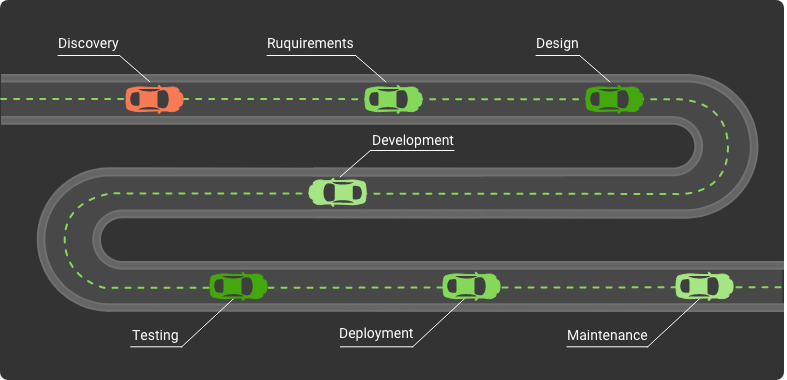
What is the Discovery Phase?
Project discovery is the first step towards building a successful web or mobile product. It is just as important as the development process itself since research determines whether a startup will succeed or fail. Project scope discovery consists of carefully collecting and analyzing the client’s requirements, gathering information on the end user’s needs, determining patterns of their behavior, analyzing the effectiveness of the idea, and calculating how much time and money it will take to implement the product.
This process is about understanding the client's business needs and identifying ways to achieve their goals with minimal investment. At an early stage, project discovery shows how appropriate it is to implement the project and evaluates whether the product will be worth the money.
Project discovery is essential for both the software development service provider and the customer. For it to be effective, the team will have to answer a number of questions in detail. Here are some:
What are the client's business and goals?
What is the target audience of the project?
Why is the user interested in the content of a website or a mobile application?
What is the result of the business analysis of the project?
What are the ways to obtain a competitive advantage?
What are the project requirements for achieving key indicators?
What is the most favorable team composition for achieving the project goals?
What should be the indicators of product success?
What is the minimum profit level for the project?
What traffic is expected after the launch of the project?
Will the product's content be up to date after launch?
What potential risks can the project face?
What can hinder the successful implementation of the product?
How much does it cost to build a website or mobile app?
What is the cost of maintaining a product after launch?
As a result, the client can create a prototype of the product and make a reasonable decision regarding implementing a website or mobile application.
At KeyUA, we adhere to three main ways of conducting research: at our office, on the client’s side, and online. We offer various options for cooperation to make the discovery process as friendly as possible. Regardless of the method of interaction you choose, you can be sure of receiving qualified advice.
Trust the implementation of your project to a team with more than 12 years of experience in developing great web and mobile applications.
Contact UsTasks of a Project Discovery Phase
As you already understand, software project discovery is a long and responsible stage. And it has several important goals. Let's look at the tasks that need to be solved before embarking on a project.
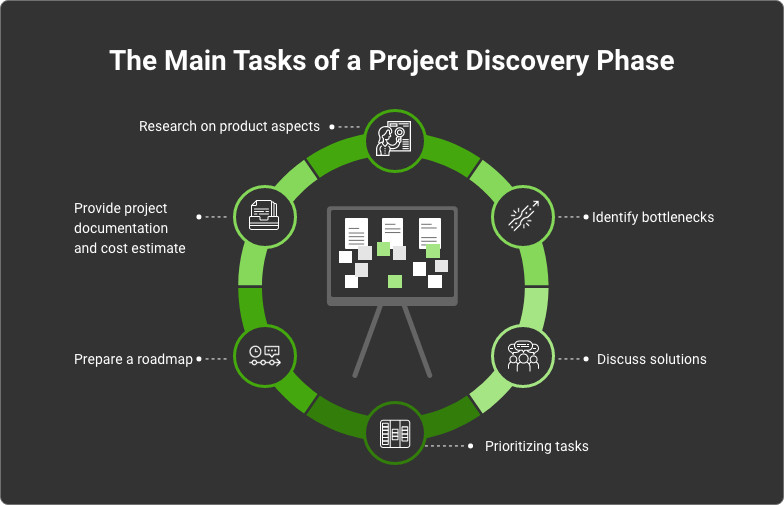
6 Tasks of a Project Discovery Phase
Research on product aspects. In this step, the team analyzes the product concept, evaluating its effectiveness. This task also covers the study of the potential user and market conditions. The client should explain how they want the product to work, its main functions, and tasks.
Identify bottlenecks. The next task is to assess the bottlenecks of the project. This must be done by the development team based on the information provided by the client. Bottlenecks can include features of business logic, complex functionality that cannot be implemented, or an incorrect technology stack, all of which will increase the time required for product delivery.
Discuss solutions. It is logical that after identifying bottlenecks, solutions should be developed for all possible problem situations.
Prioritize tasks. This is an important step for the project manager and developers. Their goal is to compile a detailed set of tasks, evaluate it, and prepare a general plan for implementing the project.
Provide project documentation and cost estimates. This involves generating all the necessary scope and time estimates. The product project manager usually does this based on the team's assessments.
Prepare a roadmap. Finally, the product manager must build a roadmap for the project. This is a visualization of the product building strategy. It answers 3 essential questions: Who? What? When? Its key feature is the indication of the relationship between all team members in completing tasks. It allows a company to effectively configure and run various components necessary for building a project. In addition, the roadmap gives the client an overall picture regarding product implementation.
Steps Required for the Project Discovery Phase
The steps to be taken mainly depend on the size of the application. Below you will find a basic list that may be changed according to the circumstances of your product.
Identify stakeholders. This list could include product owners, their representatives, investors, administrators, all members of the development team, end-users, and any other people involved in creating and using the final product.
Define business goals. You have to identify the main purpose of creating the product. What problem must the product solve for the company to make a profit? This stage means that the development team must negotiate with the customer to discuss and explain all the solutions they propose to eliminate project bottlenecks.
Methods for measuring success. What do you expect to get in the end? Think about how you will know that the project has fulfilled its purpose.
Check existing studies. If you previously conducted market analysis necessary for your project, this is the time to evaluate its current usefulness and understand the need to perform additional research.
Build a user journey. This will be useful for you to qualitatively think over the functionality of the product.
Competitor analysis. This step will allow you to find a profitable niche in which you will be most successful.
Preparation of the specification. The entire team carefully describes the requirements for the product and the connections between the functionality.
Prepare an assessment. This process means that the team estimates the time and money required to build the product and provides an agile project plan.
Key Professionals Who Are Involved in the Project Discovery Phase
Project discovery is a team effort and usually involves experts from both sides: the development service provider and the client. Below we will look at the basic composition of the team, but it can change depending on the goals and needs of the project.
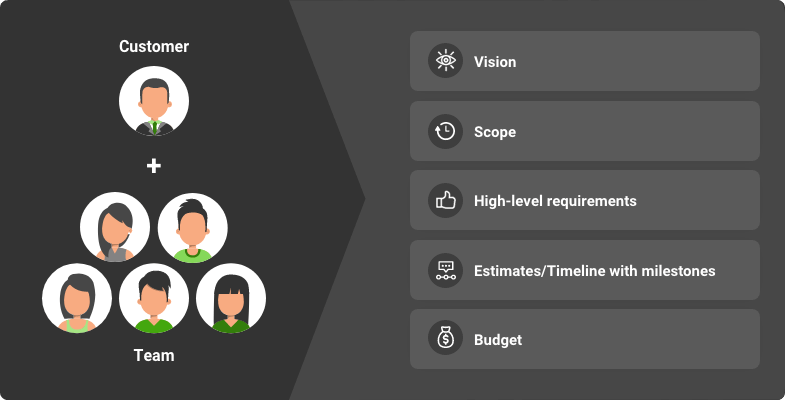
Stakeholders
This group represents the client’s side. In the case of a startup, this role is taken by the client himself. They explain the purposes and objectives that need to be completed within the project to achieve business goals. Stakeholders should clarify any questions regarding the product and its purpose for the rest of the team.
Business Analyst or Product Manager
One or two different specialists can perform these two roles. They collect, structure, and analyze the data received from the client. The mission is to formulate questions for clarification and facilitate discussing the product’s tasks and goals. BA / PM also compose user stories based on which an estimate of the time required for the project implementation can be made. In general, the main task of business analysts or product managers is to handle the communication process and make sure that both parties have the same understanding of goals, objectives, and priorities. They also prepare a development budget based on the team's estimates.
UI/UX Designer
Their task is to listen carefully to the client’s preferences and analyze the target audience and competitors. Based on these components, designers create page layouts and think over an intuitive interface so that the end-user can easily interact with the product. They should also provide an estimate of the time required to prepare the project templates.
Lead Software Developer
These specialists also analyze the client's requirements and provide technical solutions. Their task is to study the project documentation and estimate the time it will take to create the architecture and product code. The developer must ensure that the desired business logic is feasible within the specific project. In addition, the software engineer must suggest the best technology stack and platform to meet business goals.
Project Manager
Their task is to get an estimate from the developer and designer and, based on this, draw up a detailed plan for the implementation of the project. Usually, it includes dividing the project implementation into iterations (lasting 1-2 weeks), during which the team must complete specific tasks. The project plan is then passed on to the product manager to create an overall project budget and presented to the customer to understand its delivery time. On small projects, the role of business analyst and project manager is performed by one person.
At KeyUA, we have been developing scalable projects for various industries for over 12 years. We have advanced knowledge of successful product creation and effectively apply them in practice.
Contact UsWhat You Will Get After Completing Tasks of a Discovery Phase
It is almost impossible to overestimate the importance of the discovery phase. Here's what you might end up with:
Wireframes
A wireframe is a low-fidelity product design that sketches the core functionality, interactions, and structure of a product. They are a part of the product documentation that helps the developer and all other team members figure out the business logic and discuss product features within a team. Wireframes also demonstrate user interaction with the interface in static moments.

Wireframes help show features and basic transitions between screens in apps
Prototype
The prototype has the basic functionality of the application. This means that users can click and interact with the basic elements that are needed for navigation. A prototype's primary purpose is to test how the user will interact with the product and simulate their potential actions. The prototype allows getting a real user experience before the product hits the market.
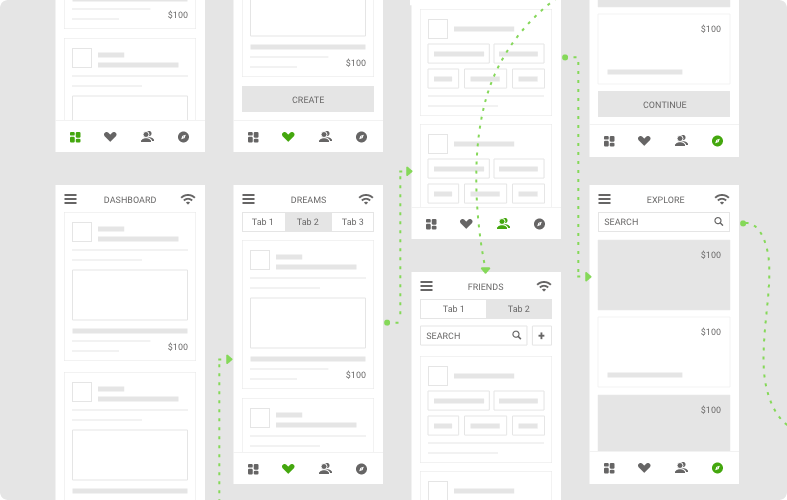
The prototype helps you check how the user interacts with the product.
Design
The previous two elements allow you to prepare the final design of your application. This step involves creating the user interface and user experience to build a truly enjoyable product that is easy to interact with.
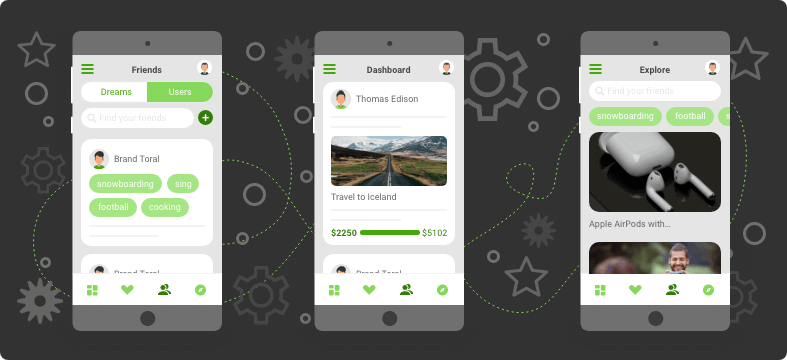
The design helps create a user interface for easy interaction
The research phase ends with receiving complete project documentation, decisions regarding the use of technologies, and, in principle, everything you need to start building a full-fledged product immediately.
Project Discovery Phase Benefits
Often, clients refuse to conduct the discovery phase, as they believe that they already have complete information and want to save money. But the reality is that lack of research can result in additional delays and budget overruns. We have covered 6 main benefits that indicate that a discovery phase is needed for any project.
1. Find the best solutions
When you conduct a detailed analysis of product needs, you have an excellent opportunity to understand exactly what is needed to complete a project successfully. You get the time and resources to find the most effective solutions that can be better and cheaper than what the client initially intended.
2. Focus on goals
The project’s success lies not only in the fact that it is delivered on time or its code is clean and manufactured, but also depends on whether the product has achieved its goals. For example, did the product get the expected traffic, or how much was the conversion improved. A vision of clear prospects and product plans can be obtained at the discovery stage. At the same time, in-depth preliminary analysis helps to design a strategy for its implementation.
3. Define user preferences
Quite often, there are situations when a client composes a product description while not understanding what the user really needs. The fate of such projects is always the same - they fail. One of the main tasks at the beginning is to find out what specific issues users want to be solved and how the product will solve them. Only in such circumstances will the project be successful. To understand what tasks the application should solve, the development team will have to figure out what interests a user and how it can be released with minimal costs. Without following user behavior, the team runs the risk of creating a project that spoils the user experience.
4. Reduce risks
More than 90% of startups fail statistically. This is due to many factors, including misunderstandings within the team, an incorrect budget, poorly thought out product functionality, and lack of focus on the potential user. The discovery phase solves all of the above issues. Projects in which detailed analysis was conducted prior to development usually go to market successfully and remain effective for a long time. This is a crucial stage because, based on the research findings, you can make quality decisions about product implementation. In some situations, it is possible to wholly or partially change the concept, which will lead to a more successful entry into the market.
5. Testing the product on the end-user
By creating a prototype and giving it to a focus group for a check, you can evaluate how effective your plan was and understand what points can be improved to make the product more convenient and profitable. This is a valuable experience that will also help you reduce development costs.
6. Planning based on facts
By gaining expert insight from research, the team can more clearly imagine the product development process. In this case, planning will take into account all the nuances, and the team will be able to avoid unnecessary actions and quickly deliver the application.
Make your product successful by partnering with KeyUA professionals.
Contact UsTips For a Better Project Discovery Process
The discovery phase of a project can be a real challenge, even for professionals. So, based on our experience, we have prepared some powerful tips to help make this process as effective as possible.
1. Make your budget proportional
Many clients refuse this stage, considering the research too expensive. It can be so if it requires in-depth analysis. But as we already understood, discovery is an integral part of product implementation. Distribute your budget evenly. If we are talking about a small product, the discovery phase should be short and require less money than large projects. In the case of small projects, the research may take 1-2 days. While for medium and large-sized ideas, it will take from 4 to 8 weeks.
2. Involve the entire team in research
Each team member evaluates projects from their own experience. Therefore, the more employees conducting research, the better the result you will get. If your product requires the implementation of artificial intelligence principles, the project should be discussed not only by the lead software engineer but also by AI specialists. If you plan to partner with the development team to conquer the market, bring in a marketer for the discovery phase in a project.
3. Make two projects
As we said, the discovery phase precedes the implementation. For medium to large scale products, it is worth approaching the research phase as a separate project. In this way, you will receive enough useful information and will have a clear idea of whether it is advisable to implement the project at all. Perhaps as you research, you will find a better and more profitable idea. Such separation benefits both the client and the development team. Firstly, the customer will understand the level of professionalism of the contractors from the very beginning. Secondly, the development team will be able to quickly find an approach to the client and establish high-quality communications even before the start of building the product.
4. Enable personal communication with the user
The user is the key element for realizing the first-class product. A good discovery phase should include team interaction with the end-user. Typically, interviews with users are personally conducted by the product manager and/or the client. But the rest of the team can also benefit from being present or watching the interview on tape.
Final Words
High-quality and detailed research before the application implementation is one of the critical factors on the path to a successful launch of the application. The discovery phase of the project management process opens up many advantages for the business—the main one being getting a complete picture of the finished product even before the developers start writing the code.
Our experience at KeyUA often shows that the discovery phase allows quickly and efficiently meeting deadlines. And while research may seem time-consuming and expensive, it is valuable to avoid budget overruns and future failures.
Need a top-notch custom app? Our team will take care of powerful project discovery and high-quality implementation of your idea.
Contact Us



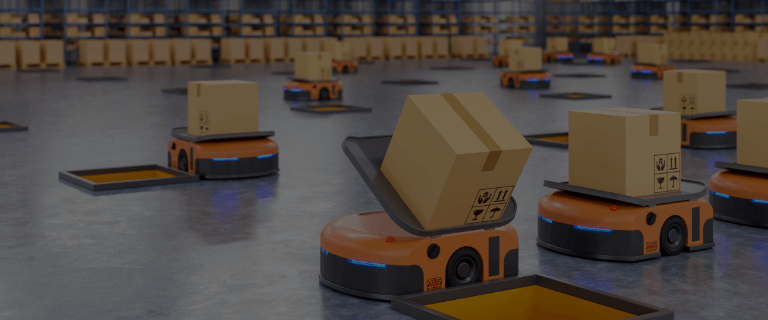



 Unit 1505 124 City Road, London, United Kingdom, EC1V 2NX
Unit 1505 124 City Road, London, United Kingdom, EC1V 2NX

Comments
Leave a comment